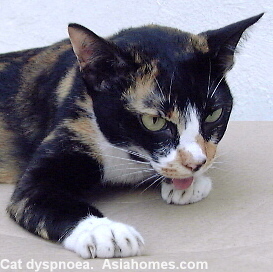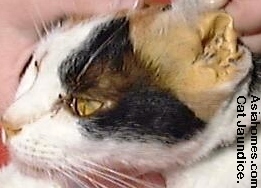| 0916Singapore
Cat Dyspnoea, Cyanosis, pet health
and welfare educational for animal lovers, excerpts from The Glamorous Vets,
Singapore, sponsored by AsiaHomes Internet. The Cat quacked.  "I know my cat will die," said Mrs Salleh as she saw her cat
releasing urine onto the examination table in the middle of
examination. Mrs Salleh had kept many cats in the Housing and
Development Board apartment and would know of cat deaths. She would never agree to my advice
just to keep one cat.
"I know my cat will die," said Mrs Salleh as she saw her cat
releasing urine onto the examination table in the middle of
examination. Mrs Salleh had kept many cats in the Housing and
Development Board apartment and would know of cat deaths. She would never agree to my advice
just to keep one cat. Now, this 3-year old cat had rapid breathing, a tongue sticking out and purplish gums. The purplish colour indicated cyanosis - not sufficient oxygen going to the red blood cells. The body temperature was 38 degree Celsius, lower than normal. Was there a fish bone stuck in its throat? I opened its mouth. No bone was seen. No laceration or fishy smell. I palpated its throat to check for any bones lodged inside. The cat literally quacked six times in a non-stop series, like a duck. It did not attempt to vomit or cough. Not meowing as expected of a cat. Just a duck's loud quack if you have heard a duck quacking since most Singaporeans will not have the opportunity to do so as there are no more duck farms in Singapore! Mrs Salleh cried as she covered her face with her hands. This was most distressing. "There is something very painful below its throat and blocking its windpipe. Probably some foreign bodies like fish bones had lodged deep inside the gullet (oesophagus) or the windpipe (trachea)." I explained. An X-ray would be necessary. It was too risky to perform surgery on a cat with dyspnoea - a cat which can't breathe. At death's door. The heart would fail and the veterinary surgeon would be blamed for its death. It was also the relatively high costs involved whenever there was surgery. The cat was given a pain killer and stablised with fluids. Antibiotics were given. It would be X-rayed as soon as possible. "What's happened to the young jaundiced cat which had yellowed eyes and ears?" I asked Mrs Salleh. Knowing the roaming habits of her cats, I suspected the young cat had been most likely to be infected by leptospirosis from catching rats and had developed jaundice. It could have been poisoned too.  "It was the son of this cat. It recovered after the injection." Mrs Salleh said. "Two
evenings later, three of its litter mates
had the same yellow skin and ears. I sent them to the hospital at night as
emergency cases."
"It was the son of this cat. It recovered after the injection." Mrs Salleh said. "Two
evenings later, three of its litter mates
had the same yellow skin and ears. I sent them to the hospital at night as
emergency cases.""What happened to them?" I asked. "They all died," Mrs Salleh winced recalling the incident. "The treatment cost so much more and they all died the next day." I explained to Mrs Salleh. "The cat I treated recovered because it was treated earlier. The other three died because the toxins in the bloodstream or the bacteria germs had caused too much damage to the body. The cats would have died even if they were treated by another veterinarian. It had nothing to do with the competence of the hospital veterinarians." Mrs Salleh appeared convinced but did not say a word. The cost of veterinary treatment has always been an important consideration  for owners who love and maintain many stray
cats all over the world.
There just isn't much money to spare for more investigations like blood
test for leptospiral bacteria or other diseases when there are more cats than
money to do a proper job of diagnosis. A report says that a
pair of cats could produce over 400,000 cats in 7 years and this may be
the reason why most governments could not eliminate the feral or stray
cats at least cost. for owners who love and maintain many stray
cats all over the world.
There just isn't much money to spare for more investigations like blood
test for leptospiral bacteria or other diseases when there are more cats than
money to do a proper job of diagnosis. A report says that a
pair of cats could produce over 400,000 cats in 7 years and this may be
the reason why most governments could not eliminate the feral or stray
cats at least cost. Singapore may be a developed nation but there are kind cat lovers who survive day to day feeding and looking after the welfare of feral cats and sometimes bringing them to the veterinarian for treatment. As for the cat that quacked, it died within ten hours. It was a well fed cat with much freedom to wander round the neighbourhood and to meet friends. The onset of the dyspnoea or difficult breathing was said to be sudden. The continuous vocal "quacking" sound elicited from the mother cat on my palpation of the throat area behind the larynx indicated an extremely painful area. I presumed that a large foreign body must have lodged deep in the windpipe at the bifurcation of the trachea. It could be lodged deep in the oesophagus or gullet near the heart and obstructing the airway. This made it very difficult for the cat to breathe.  It
did look like it had a swollen abdomen and could be suffering from the
Feline Infectious Peritonitis viral infection but the swelling could be
due to fat. An
autopsy to determine the cause of death was not done as the Owner did not
want it to be done. The cat's roaming lifestyle gives it a lot
of freedom but there was a price to pay - infection by viruses from other
stray cats, poisoning by cat haters and traumatic injuries and infections
from cat bite wounds. It
did look like it had a swollen abdomen and could be suffering from the
Feline Infectious Peritonitis viral infection but the swelling could be
due to fat. An
autopsy to determine the cause of death was not done as the Owner did not
want it to be done. The cat's roaming lifestyle gives it a lot
of freedom but there was a price to pay - infection by viruses from other
stray cats, poisoning by cat haters and traumatic injuries and infections
from cat bite wounds.
|